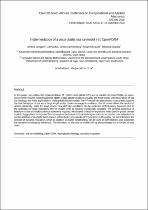JavaScript is disabled for your browser. Some features of this site may not work without it.
- ResearchSpace
- →
- Research Publications/Outputs
- →
- Conference Publications
- →
- View Item
| dc.contributor.author |
Bogaers, Alfred EJ

|
|
| dc.contributor.author |
Jansen van Rensburg, GJ

|
|
| dc.contributor.author |
Marquart, R

|
|
| dc.contributor.author |
Skatulla, S

|
|
| dc.date.accessioned | 2018-10-23T12:40:39Z | |
| dc.date.available | 2018-10-23T12:40:39Z | |
| dc.date.issued | 2018-09 | |
| dc.identifier.citation | Bogaers, A.E.J. et al. 2018. Implementation of a visco-plastic sea ice model into OpenFOAM. Eleventh South African Conference on Computational and Applied Mechanics (SACAM 2018), Vanderbijlpark, South Africa, 17-19 September 2018 | en_US |
| dc.identifier.uri | http://hdl.handle.net/10204/10490 | |
| dc.description | Paper presented at the Eleventh South African Conference on Computational and Applied Mechanics (SACAM 2018), Vanderbijlpark, South Africa, 17-19 September 2018 | en_US |
| dc.description.abstract | In this paper, we outline the implementation of Hibler’s visco-plastic (VP) sea ice model into OpenFOAM, an opensource finite-volume modelling toolkit. Hibler’s visco-plastic model is arguably the most widely used description of sea ice rheology, and finds application in most global climate models. The VP model has been shown to accurately capture the bulk behaviour of sea ice at large length scales. Under convergent conditions, the VP model allows the sea ice to deform plastically, while for small strains, near drift like conditions can be captured. Unfortunately however, due to the potential for large viscosities, the VP model tends to become numerically unstable. The general consensus in literature is that an implicit solution scheme is required, which tend to become expensive when used in global climate models. Suggestions to improve the convergence behaviour include techniques such as successive over-relaxation or via the addition of an elastic term, known as the elastic-visco-plastic (EVP) method. In this paper, we aim introduce the concept of dynamic relaxation, which in addition to matrix conditioning, can be used to both stabilise and accelerate the iterative convergence behaviour. The behaviour of the sea ice model will be demonstrated on a number of test cases. | en_US |
| dc.language.iso | en | en_US |
| dc.relation.ispartofseries | Worklist;21444 | |
| dc.subject | Sea ice modelling | en_US |
| dc.subject | OpenFOAM | en_US |
| dc.subject | Visco-plastic rheology | en_US |
| dc.subject | Dynamic relaxation | en_US |
| dc.title | Implementation of a visco-plastic sea ice model into OpenFOAM | en_US |
| dc.type | Conference Presentation | en_US |
| dc.identifier.apacitation | Bogaers, A. E., Jansen van Rensburg, G., Marquart, R., & Skatulla, S. (2018). Implementation of a visco-plastic sea ice model into OpenFOAM. http://hdl.handle.net/10204/10490 | en_ZA |
| dc.identifier.chicagocitation | Bogaers, Alfred EJ, GJ Jansen van Rensburg, R Marquart, and S Skatulla. "Implementation of a visco-plastic sea ice model into OpenFOAM." (2018): http://hdl.handle.net/10204/10490 | en_ZA |
| dc.identifier.vancouvercitation | Bogaers AE, Jansen van Rensburg G, Marquart R, Skatulla S, Implementation of a visco-plastic sea ice model into OpenFOAM; 2018. http://hdl.handle.net/10204/10490 . | en_ZA |
| dc.identifier.ris | TY - Conference Presentation AU - Bogaers, Alfred EJ AU - Jansen van Rensburg, GJ AU - Marquart, R AU - Skatulla, S AB - In this paper, we outline the implementation of Hibler’s visco-plastic (VP) sea ice model into OpenFOAM, an opensource finite-volume modelling toolkit. Hibler’s visco-plastic model is arguably the most widely used description of sea ice rheology, and finds application in most global climate models. The VP model has been shown to accurately capture the bulk behaviour of sea ice at large length scales. Under convergent conditions, the VP model allows the sea ice to deform plastically, while for small strains, near drift like conditions can be captured. Unfortunately however, due to the potential for large viscosities, the VP model tends to become numerically unstable. The general consensus in literature is that an implicit solution scheme is required, which tend to become expensive when used in global climate models. Suggestions to improve the convergence behaviour include techniques such as successive over-relaxation or via the addition of an elastic term, known as the elastic-visco-plastic (EVP) method. In this paper, we aim introduce the concept of dynamic relaxation, which in addition to matrix conditioning, can be used to both stabilise and accelerate the iterative convergence behaviour. The behaviour of the sea ice model will be demonstrated on a number of test cases. DA - 2018-09 DB - ResearchSpace DP - CSIR KW - Sea ice modelling KW - OpenFOAM KW - Visco-plastic rheology KW - Dynamic relaxation LK - https://researchspace.csir.co.za PY - 2018 T1 - Implementation of a visco-plastic sea ice model into OpenFOAM TI - Implementation of a visco-plastic sea ice model into OpenFOAM UR - http://hdl.handle.net/10204/10490 ER - | en_ZA |






